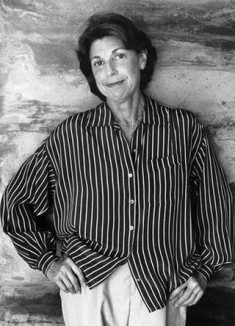Having journeyed through a period of time in the mid-20th century in which abstract art evolved in extraordinary ways, both through method and impression, Helen Frankenthaler bravely explored new techniques with stunning results.
The Early Years
Born in Manhattan in 1928, Helen Frankenthaler did not share a similar period of growing as some artists. Far from starving, she grew up in the affluent Upper East side of Manhattan. Her father served as a renowned judge of the New York State Supreme Court, and Helen enjoyed the benefits of growing up as a child of privilege.
Her love of art was evident from an early age. One early recollection to this effect was that she frequently filled a sink with water and then gently poured nail polish into the water. She loved to simply watch the designs as the color traveled through the water.
Schooling and Education
Educated in some of the finest schools, such as Dalton School and Bennington College, Frankenthaler later developed a strong friendship with Clement Greenberg which lasted for five years. This relationship had a profound influence on her artistic endeavors. The relationship, which began in 1950, brought her into contact with artists such as Jackson Pollock and David Smith. Greenberg also encouraged Helen to showcase her work by joining the prestigious Tibor de Nagy Gallery, which was where she eventually displayed her first solo show.
Frankenthaler later married Robert Motherwell, who was also an artist from an affluent family. Together, they were known as the “golden couple” who entertained celebrities and dignitaries with lavish parties. The marriage began in 1958, but it ended in divorce in 1971. Frankenthaler married Stephen M. DuBrul, Jr., a prominent banker with the Ford Corporation, in 1994 and remained married to him until the time of her death in 2011.
Styles and Techniques
One of the most important contributions to impressionistic art contributed by Frankenthaler was her furtherance of a technique originally developed by Pollock. Known as “color field,” Pollock developed this method by pouring enamel paint directly onto unprepared canvas.
Taking this method a step further, Frankenthaler mixed turpentine with the paint. This changed the composition of the paint, making it more readily absorbed by the fabric of the canvas. It also gave the paintings an ethereal quality that resembled watercolors.
Frankenthaler experimented with this technique on a grand scale with some paintings that were massive in size and being exhibited. She expressed impatience with those who painstakingly tried to perfect every brush stroke, saying that the painting should reflect that which is in the head, the heart, and the hand simultaneously. Believing that a good picture was one that instantly projected its image to the person viewing it, Frankenthaler illustrated her technique in perhaps her most famous painting, Mountains and Sea, in 1952.
Critical Reactions
Although considered to be an artistic genius by the vast majority of critics, not all were complimentary of Frankenthaler’s work. Some called it too poetic and claimed that it lacked substance. Others have criticized the manner in which the color field method causes the untreated canvas to deteriorate.
Yet, even with such criticism, Frankenthaler’s work has been lauded by respected and admired critics who praise her ingenuity, spontaneity, and ability to capture an image’s complexity in the human mind.
Frankenthaler’s Later Years
Frankenthaler’s twilight years were spent with her second husband on Long Island Sound. Much of her later work reflects this as there was a greater focus on imagery of sound, water, and light. While some of her work seemed to flow towards more definition, her famous spontaneity always resurfaced. In a 2003 interview with the New York Times, she said that there was no specific formula to artwork and it was important to allow the picture to lead the artist.
Frankenthaler also experimented with sculpture. She received praise from several critics for her work in this field. Even though she expressed enjoyment of this venue, she did not pursue it further, returning instead to her painting.
